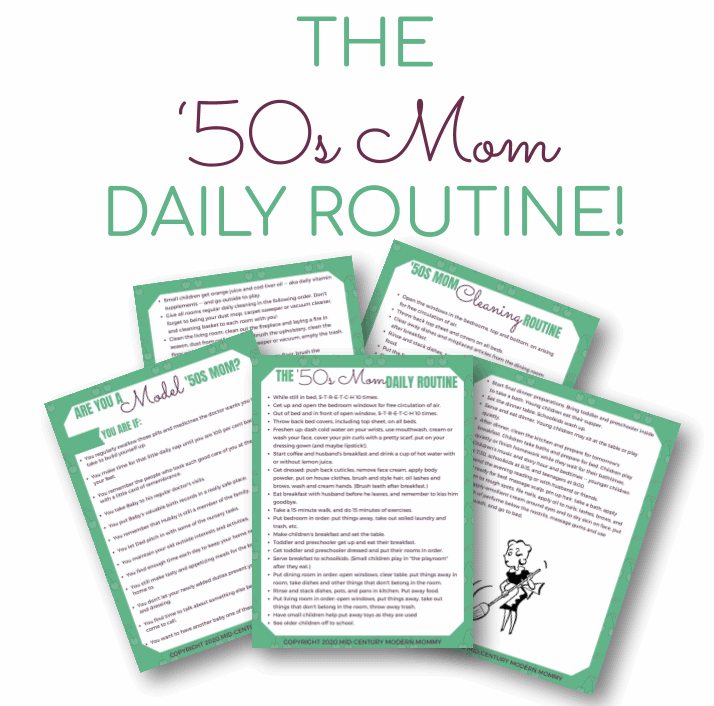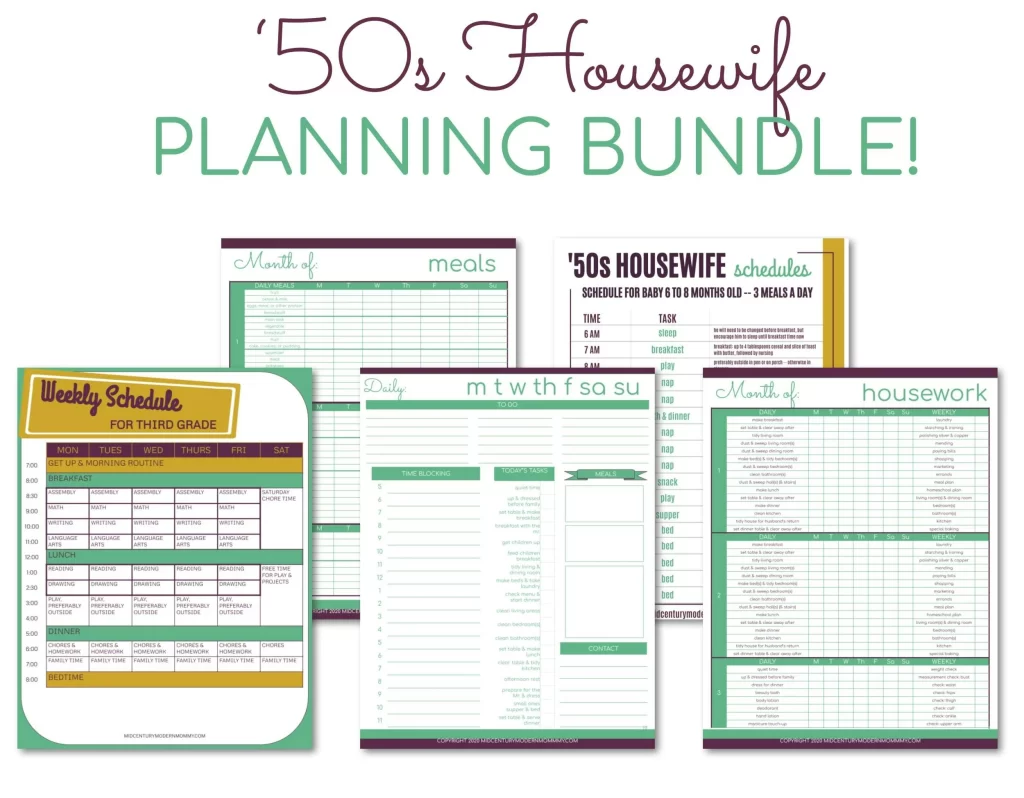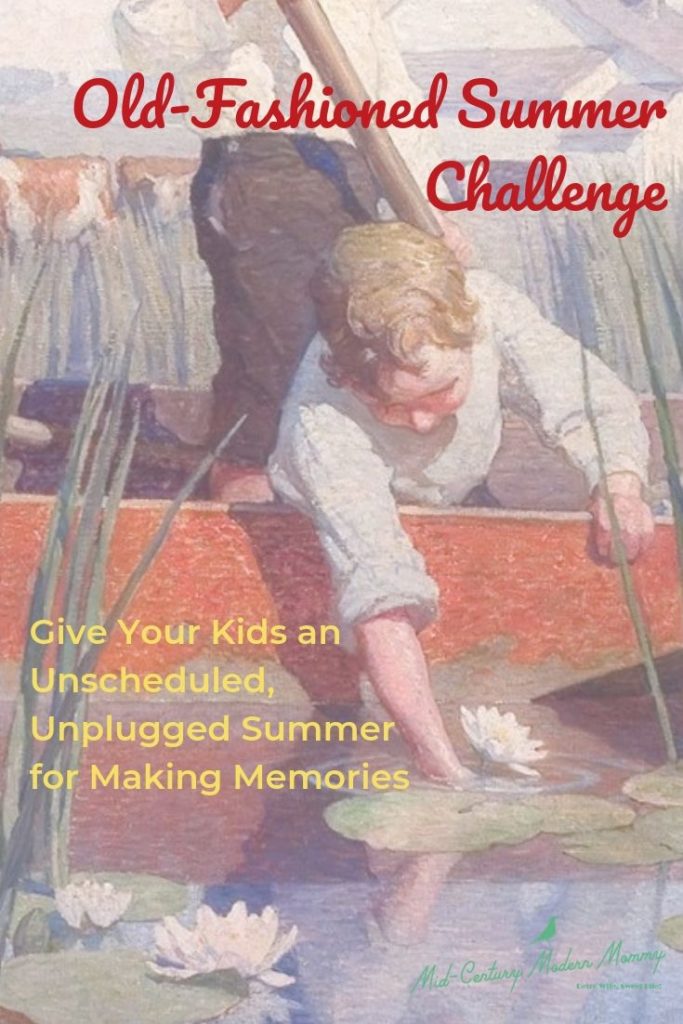When it comes to preparing your child for school, sometimes the best methods are those that have stood the test of time.
Vintage learning methods, deeply rooted in traditional education, offer a structured and holistic approach to early education. These tried-and-true techniques not only instill foundational academic skills but also nurture discipline, creativity, and character. Believe it or not, self-discipline is actually the most important skill to develop in your child for future success.
In this article, we’ll explore how to bring these timeless methods into your modern home, setting your child up for real success in school and beyond.

Get Our Mid-Century Mom Daily Routine FREE!
Understanding Vintage Learning Methods
One of the cornerstones of vintage education is the 3R method: Reading, Writing, and Arithmetic.
These three pillars provide a solid foundation for all future learning. In a world increasingly dominated by screens, physical books, and handwriting play a crucial role in this approach.
The tactile experience of holding a book and the practice of forming letters by hand enhances cognitive development and memory retention far more effectively than digital alternatives.
As a mother dedicated to giving your child the best start, embracing vintage learning methods can help you create an enriching and disciplined learning environment.

What Are Vintage Learning Methods?
This post contains affiliate links. If you click a link and make a purchase, I may receive, at no additional cost to you, a small commission. Find out more on my Disclosures page, and thank you so much for your support!
Vintage learning methods encompass a range of traditional educational techniques that were widely used in the past, particularly before the advent of modern technology in classrooms.
These methods prioritize direct instruction, hands-on learning, and a strong emphasis on foundational skills. Vintage methods also integrate academic learning with moral and character development, believing that traits like self-discipline, truthfulness, and diligence are more important than even literacy. (Although they also emphasize that literacy leads to these traits.)
At the heart of these methods are timeless resources such as Webster’s Speller, the New England Primer, and McGuffey’s Readers. These classic texts were written to build literacy and numeracy from the ground up, promoting fluency and comprehension through repetitive practice and memorization. They emphasize a mastery approach to skills like reading, writing, math, and memorization.
These methods also emphasized common cultural literacy and the development of a strong moral compass through the content of the reading.

Core Principles of Vintage Education
Vintage education is built on several core principles that distinguish it from many modern approaches. These principles focus on creating a well-rounded, disciplined, and capable learner.
Emphasis on Discipline and Structure
Discipline and structure were crucial in 19th-century American culture, much like in the revival of Stoicism today, because they provided security in a world that felt uncertain, volatile, and even dangerous.
Strict adherence to routines and self-discipline helped individuals navigate the social and economic landscape of the era, fostering a sense of order and predictability in their lives. Vintage education also stresses the importance of a disciplined learning environment. This includes structured daily routines, clear expectations, and consistent practice.
The security and boundaries of routine, expectation, and clear guidelines help children develop self-control, resilience, and a strong work ethic, which leads to future success, even in uncertain times.
Foundational Skills: Reading, Writing, Arithmetic, Memorization
Skills practice is central to traditional education.
Reading is taught through phonics and classic literature, which also covers content, like history, science, and geography. Writing is developed through cursive practice and copywork, and eventually through composition. Arithmetic focuses on math facts, mental math and practical applications.
Memory means remembering important facts and cultural concepts, such as memorizing the alphabet, spelling rules, grammar and punctuation rules, science facts, states and capitals, historic dates, and vocabulary.
These skills form the bedrock of all future learning. They are skills that must be practiced every day. Fortunately, you don’t need to start with much more than 5-10 minutes for each skill every day, at least in 1st grade.
Moral and Character Education
Beyond academics, vintage methods emphasize the development of moral values and character.
We can guide our children to choose good behavior, but we can’t force it upon them. The key to developing good character is to require self-control. Without self-control, we are at the mercy of our passions. One effective way to instill this is by saying no to your child more often than yes. This approach isn’t about feelings; it’s about mastering one’s passions.
Another way to create good character is to teach good manners. Good character means paying attention to others and looking for opportunities to serve others. Good manners are a way of paying attention to others and looking for opportunities to serve others.
Good character is about respect for others. Good manners are demonstrations of respect for others. Controlling your own passions instead of spilling them everywhere is a demonstration of respect for others.
Stories and fables with clear ethical lessons, discussions about virtues, and community involvement give examples and teach what is expected, but the authority of parents and teachers is what confirms it.
Hands-On Learning and Practical Skills
Vintage education often includes practical, hands-on activities that connect learning to real life.
Traditionally, chores and hands-on activities were simply part of life. Thus, girls learned needlework and home management; boys practiced their martial arts. Science meant observing and recording information, whether as a nature journal, or conducting experiments.
Sport and games involved better fighting and physical prowess, like hunting, boxing, archery, etc. Play involved social learning as well as physical learning. And religion was taught through daily practice, ususally within both the family and the community.
Making time every day to develop real-world experience is part of education, which is why play – inside and outdoors – is an important part of early years learning.
By incorporating these principles, you can create a rich educational experience for your child, blending the best of traditional methods with the needs of today’s learners.
This approach not only prepares them academically but also instills a sense of responsibility, curiosity, and integrity.
With vintage learning methods, you’re not just teaching your child to succeed in school; you’re equipping them to thrive in all areas of life.

Get Our Mid-Century Mom Daily Routine FREE!
Preparing Your Child for School: Step-by-Step Guide
The goal of raising your children is not for you to “survive” raising them.
It’s to guide your child to “thrive” as an adult, because you taught them to be disciplined, motivated, prepared, caring, honest, well-mannered, responsible and independent adult.
The best teaching time that you have is from birth to school age, and what they learn during this time is what sets them up for success.
Creating a Structured Routine
Creating a structured routine is essential for preparing your child for school with vintage learning methods.
Start by designing a daily schedule that balances academic, recreational, and household activities. Consistency is key; a predictable routine helps children understand expectations and develop self-discipline. Begin the day with a set wake-up time, followed by a structured sequence of activities, such as morning chores, independent playtime, and family meals.
A well-organized day fosters a sense of security and helps children thrive.
Setting Up a Vintage Learning Space
Once your child goes to school, a dedicated learning space will really help your child’s focus and productivity.
Choose a quiet, distraction-free area of your home, like a desk in their room, is necessary as children get older, but at first, the best place is a kitchen table, where they can be near you and reconnect after a long day at school. Equip them with essential tools like a chalkboard, classic books, notebooks, and writing supplies. Incorporate vintage décor to create an inspiring environment that reflects the timeless elegance of traditional education.
The goal is to make this space both functional and aesthetically pleasing, encouraging your child to look forward to their study time.
Teaching Foundational Skills the Vintage Way
Vintage learning methods place a strong emphasis on the 3R method: Reading, Writing, and Arithmetic.
Reading
Start with phonics using resources like Webster’s Speller and gradually introduce classic literature. Regular read-aloud sessions are more important than either a strict whole-word or phonics method, to accustom kids to the practice of reading. They need to see you read. Once they are reading well, begin executing at least an hour of reading by themselves every day – and you should be doing it too!
Writing
Teaching cursive and handwriting by hand is essential for a child’s development, not just academically but also for fostering fine motor skills and cognitive growth.
Fluent handwriting is produced without needing visual guidance, as the brain stores motor plans for each letter, allowing for rapid, pre-planned movements. This direct link between seeing, hearing, or thinking about a letter and the motor plan improves efficiency and speed, making handwriting a natural, almost effortless task. By teaching cursive first, children develop strong, clear handwriting skills early on, avoiding the bad habits that come from learning to print first.
This approach also enhances reading and spelling abilities, as cursive helps differentiate similar letters and requires a disciplined, left-to-right motion that mirrors reading patterns. Additionally, cursive benefits left-handed children by promoting a more natural writing position. It even helps with dyslexia!
Focus on cursive practice and copywork to develop fine motor skills and reinforce spelling and grammar. Penmanship drills, although traditional, are incredibly effective.
Arithmetic
Traditional math teaching methods emphasize the importance of mastering arithmetic fundamentals before moving on to complex concepts like algebra.
By focusing on foundational skills such as shapes, colors, patterns, and basic arithmetic operations, children develop a strong mathematical base. This methodical approach ensures that children understand the essential elements of math through hands-on learning and repetition, fostering confidence and competence in their mathematical abilities.
Mental math and flashcards are excellent tools for teaching arithmetic. Practical applications, such as cooking measurements and budgeting, help solidify these skills.
Incorporating Hands-On Learning
Remember the 1954 report card that floats around the internet and gets revived every few years?

These activities make learning interactive and enjoyable, fostering a love for discovery, and also provide the beginnings of self-sufficiency. Children at this age should have been following you around watching and “helping” with cooking, gardening, cleaning, and all the other Montessori activities.
Hands-on daily activities and sensory play are vital components of real, traditional childhood.
Fostering a Love for Reading
To instill a lifelong love of reading, curate a library of classic children’s books.
Set aside daily family reading time to enjoy these stories together. Encourage independent reading by creating cozy reading nooks and offering a variety of books that cater to your child’s interests. Collect classic picture books, and also read-aloud books like the Book of Virtues or The Random House Book of Fairy Tales.
Expect your children to spend an hour or two reading every day – it’s a good replacement for a nap as they get older, even if they are just looking at picture books.
Building Moral and Character Education
Vintage learning methods also focus on developing moral values and character.
Children need to learn the values of honesty, respect for others, and diligence. They also need to learn to be courteous and money-wise. And you will need to help them develop self-discipline, have high expectations for them, and nurture their motivation.
These 8 things, in addition to developing reading and math readiness, are crucial to setting your child up for success. In fact, without these 8 things, math and reading ability won’t help your child succeed.

What age is appropriate to start using vintage learning methods?
I start vintage methods very early – by using vintage baby schedules all the way through preschool.
These schedules make it easy to provide the structure that helps children feel more secure and sets them up for success. They also gradually introduce more learning, responsibilities, and age-appropriate play.
By the time my children get to the preschool schedule, they have almost every foundation for their future success in place, and my work becomes much easier.
How do I balance vintage learning with technology use?
I am, frankly, a digital minimalist.
Know about problems inherent in putting your kids’ photos and stories on social media, as well as the potential problems with smartphones – but you don’t have to be screen-free. My children watch TV and movies, and my teens and husband play co-op video games together. But my children more often play outside, go to the library, and enjoy analog social media — that is, real-world social activities, like having friends over on a regular basis, visiting with neighbors, hosting community or religious groups at your house.
It is possible to help your children find a healthy balance in a tech-obsessed world.
Are vintage learning methods suitable for all children?
Vintage learning methods are highly adaptable and can be tailored to suit different learning styles and needs.
I have children who are gifted. I also have children with ADHD and dyslexia. And I can say that these methods work exceptionally well to set them up for success.
Your mileage may vary, but these methods WORK.
Embracing vintage learning methods can transform your child’s educational journey, blending the wisdom of the past with the demands of the present.
By creating a structured routine, teaching important values and behavior, and focusing on foundational readiness skills, you prepare your child for academic success and personal growth.
These timeless techniques have helped countless children, including my own, thrive in their educational endeavors. As a mother dedicated to giving your child the best start, you have the tools and knowledge to make a profound impact.




